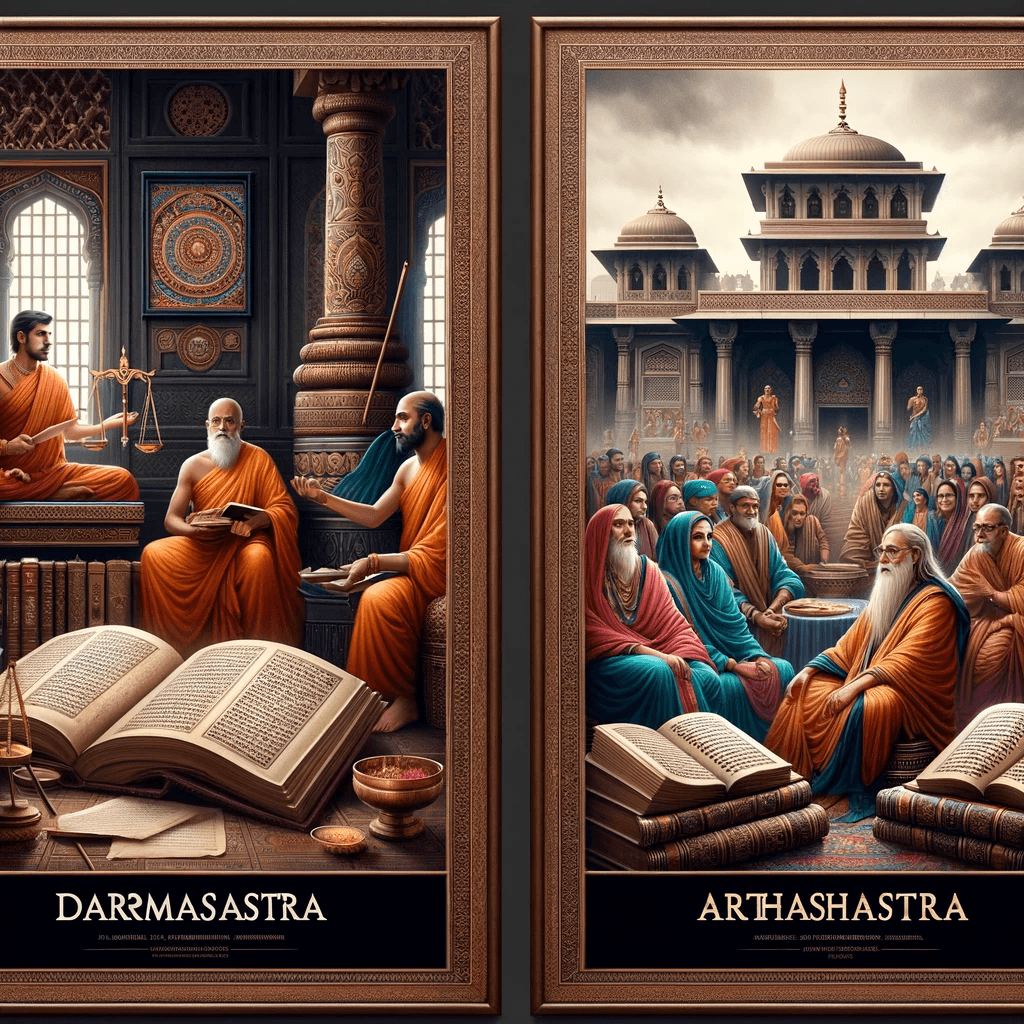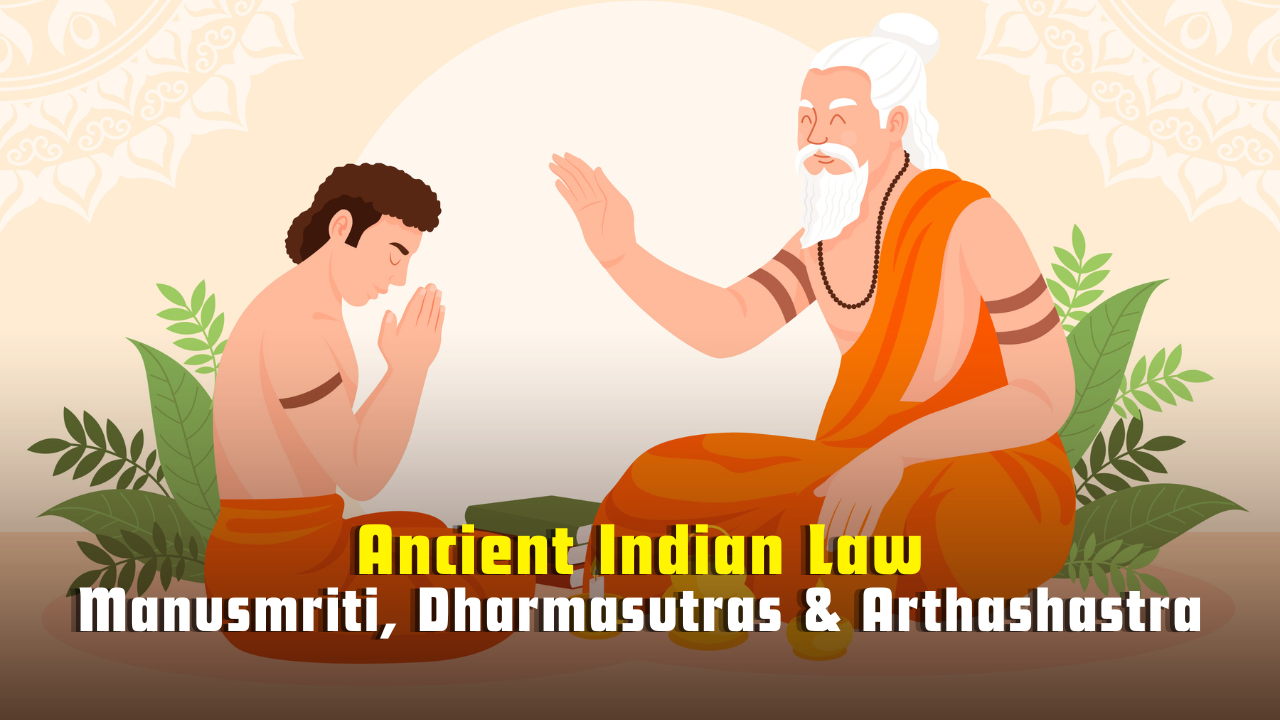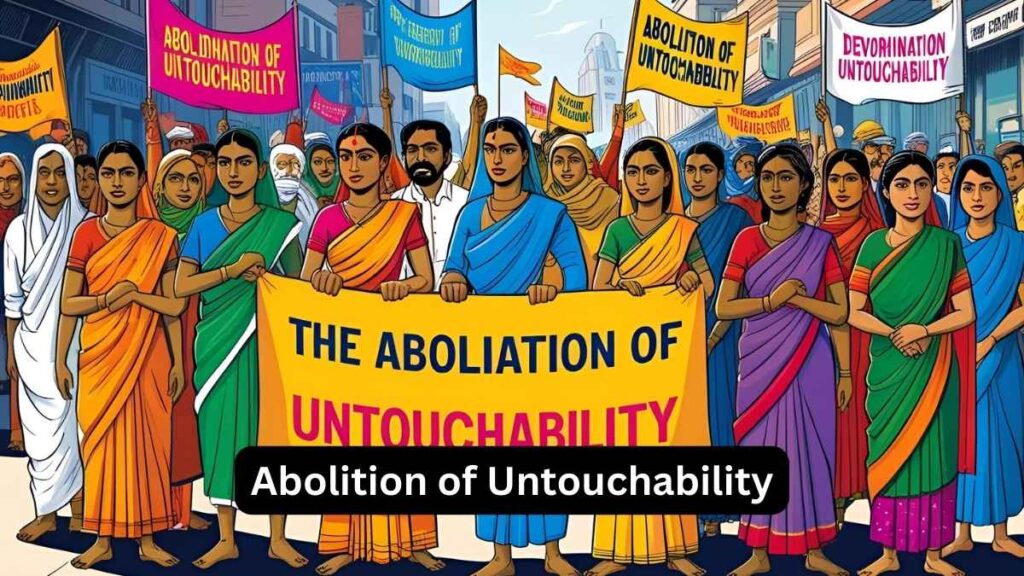Ancient Indian Law: Manusmriti, Dharmasutras & Arthashastra
Explore ancient Indian legal systems through Manusmriti, Dharmasutras, and Arthashastra. Key for UPSC—ethics, governance, caste, and social justice.
Understanding the Foundations of Legal and Social Systems in Ancient India
The topic “Ancient Indian Law: Manusmriti and Beyond” is crucial for UPSC due to its interdisciplinary relevance. It helps analyse ancient Indian society, legal systems, and governance (GS-I); contrasts with modern constitutional values like equality and justice (GS-II); and connects to social reform movements (GS-I). Understanding its ethical and discriminatory aspects aids in essays and ethics (GS-IV), while its historical significance enriches interview discussions. This makes it vital for a comprehensive UPSC preparation.

Introduction: Ancient Indian Law
The legal traditions of ancient India offer a fascinating window into the deeply interconnected world of law, religion, and social order. Unlike modern legal systems that are often codified through statutes and secular institutions, the legal frameworks of early Indian society emerged from a blend of spiritual beliefs, customary norms, and pragmatic governance principles. This intricate interplay gave rise to a sophisticated yet layered system of law, shaped by the Vedas, Manusmriti, Dharmasutras, and the Arthashastra.
This article explores the evolution of ancient Indian law by examining the key texts and ideologies that influenced societal behavior and justice. From the Manu Smriti’s moral codes to Kautilya’s Arthashastra and the community-based Dharmasutras, this study sheds light on the intellectual and cultural forces that laid the foundation of Indian legal and social systems—many of which still echo in India’s legal thought today.
Objective of the Study
The primary objective of this exploration is to critically analyze and synthesize the foundational legal texts of ancient India, with a focus on:
- The religious and philosophical underpinnings of Indian law
- The influence of social structures such as caste (varna) and life stages (ashrama)
- The evolution of legal administration and judicial systems
- The legacy of ancient texts in shaping modern Indian jurisprudence
Sources Consulted
This study draws upon an interdisciplinary collection of primary and secondary sources:
- Dharmasutras (Gautama, Apastamba, Baudhayana, Vasistha)
- Manusmriti (Laws of Manu) — translated by Wendy Doniger and Brian K. Smith
- Kautilya’s Arthashastra — translated by R. Shamasastry
- Sacred Books of the East — edited by F. Max Müller
- The Law Codes of Ancient India by Patrick Olivelle

I. Legal Foundations in the Vedic Period
The Vedas: The Bedrock of Dharma
The Vedas, the earliest known scriptures of Hinduism (composed between 1500 BCE and 500 BCE), are not legal codes per se, but they form the ethical and ritual foundation upon which legal principles later developed. They emphasized concepts like:
- Rta (cosmic order) – The precursor to the idea of dharma (duty or righteousness)
- Yajnas (sacrifices) – Ritual obligations that reinforced moral behavior
- Samskaras (sacraments) – Life-stage ceremonies that created social structure
Though abstract, these concepts would become the cornerstone of Indian jurisprudence through the Dharmashastra tradition.
II. Manusmriti: The Basis of Hindu Law
The Manusmriti, also known as Manava-Dharmasastra or the Laws of Manu, is a foundational text of Hindu jurisprudence. Traditionally attributed to sage Bhrigu, who is believed to have transcribed the teachings of Manu, the text combines legal, moral, social, and religious prescriptions. Its composition is dated between 200 BCE and 200 CE.
Historical Context and Structure
Compiled during a period of transition—when ancient Vedic ideals were adapting to newer societal needs—the Manusmriti blends dharma (moral law) and artha (statecraft). It contains 12 chapters, covering themes from cosmology to civil law, ritual duties, governance, and liberation. Over 50 manuscripts exist, with Kulluka Bhatta’s Kolkata edition being the most cited. Early European translations emerged as early as the 18th century.
Legal Framework
The Manusmriti outlines four sources of dharma:
- Vedas (supreme authority)
- Smriti (tradition)
- Conduct of the virtuous
- Conscience (self-satisfaction)
This hierarchy integrates scripture, custom, ethics, and personal judgment into a flexible yet structured system.
Social Hierarchy: The Varna System
It codifies the varna (caste) system into four ranks:
- Brahmins – priests, scholars
- Kshatriyas – rulers, warriors
- Vaishyas – traders, farmers
- Shudras – laborers, servants
Justice was unequally applied, with harsher penalties for lower castes. Shudras were denied upanayana (sacred initiation), further excluding them from religious life.
Gender and Family Law
The Manusmriti enforces patriarchy, prescribing:
- Lifelong female dependence (father → husband → son)
- Restricted education and rituals for women
- Unequal inheritance and strict marriage regulations
- Harsh punishments for female adultery
- Widowhood restrictions, limiting autonomy
While historically influential, these aspects have been widely criticized for promoting gender inequality.
Legal Procedures and Governance
Book 8 outlines a detailed system of judicial administration, including:
- Court procedures (evidence, witness rules)
- Civil law (contracts, debts, property)
- Criminal law (punishments for theft, violence, etc.)
Though it appears to support impartial justice, it privileges Brahmins in both legal authority and reduced punishment.
Legacy
The Manusmriti influenced not just Indian law but legal traditions across Southeast Asian Hindu kingdoms. Even after colonial reforms reduced its legal standing, it remains a key reference in Hindu law, while also provoking ongoing debate over its discriminatory provisions.
III. The Dharmasutras: Localised Legal Frameworks
The Dharmasutras predate and coexist with Manusmriti. These are community-specific law books composed by different sages between 600 BCE and 200 CE.
Key Texts and Their Contributions:
| Text | Author | Notable Themes |
| Gautama Dharmasutra | Sage Gautama | Earliest legal text, focused on civil and sacrificial laws |
| Apastamba Dharmasutra | Sage Apastamba | Emphasis on moral conduct, daily rituals, and legal adjudication |
| Baudhayana Dharmasutra | Sage Baudhayana | Marriage, inheritance, and ritual conduct |
| Vasistha Dharmasutra | Sage Vasistha | Detailed moral code and penalties for misconduct |
Common Themes in Dharmasutras:
- Social duties according to varna and ashrama (life stage)
- Rules for marriage, inheritance, property, and penance
- Establishment of judicial procedures and courts
- Emphasis on religious observance and ethical living
✦ The Dharmasutras reflect regional variations in customs, highlighting the decentralized and adaptable nature of ancient Indian legal thought.
IV. Kautilya’s Arthashastra: Statecraft and Secular Law
The Arthashastra, attributed to Chanakya (Kautilya) during the Mauryan Empire (c. 3rd century BCE), differs from religious legal texts by focusing on pragmatic governance and economic policy.
Legal and Political Insights from the Arthashastra:
- Dandaniti (Science of Punishment): Law as a tool to maintain public order
- Secular Justice: Emphasis on logic, evidence, and empirical rules
- Rule of Law: The king was bound by dharma and expected to ensure impartial justice
- Administrative Efficiency: Comprehensive bureaucracy for tax collection, espionage, military, and welfare
✦ Unlike the Manusmriti, the Arthashastra proposed laws based on state interests rather than caste or religious morality.
V. The Role of Caste and Customary Laws
Caste (Varna) and Legal Identity
Ancient Indian legal codes consistently reinforced a hierarchical social order, wherein one’s legal rights and punishments were determined by caste status. While this system promoted stability and clarity, it also led to systemic discrimination and social rigidity.
Smriti and Customary Laws
‘Smritis’ (that which is remembered) evolved from the collective memory and traditions of specific communities. These local laws operated parallel to pan-Indian texts like Manusmriti and were often more context-sensitive and practical.
VI. The Judiciary in Ancient India
Structure of the Legal System:
- Gram Sabha – Local village councils
- Kula and Sreni Courts – Clan or guild-based arbitration
- Rajya Sabha – King’s court; supreme appellate authority
- Brahmin Councils – Specialized in interpreting religious and dharmic law
Legal Officials:
- Dharmadhikarin – Judge appointed by the king
- Amatyas – Ministers overseeing legal implementation
- Sabhapati – Presided over village courts
✦ The king was considered the final arbiter, expected to uphold both dharma and legal order.
VII. Comparative Overview of Key Legal Texts
| Aspect | Manusmriti | Dharmasutras | Arthashastra |
| Nature | Religious & Social | Ritual & Local Legal Norms | Secular State Policy |
| Focus | Dharma, caste, purity | Life-stage duties, rituals | Governance, economy, espionage |
| Judiciary | King advised by Brahmins | Community arbitration | State-centric legal process |
| View on Justice | Divine and moral | Ethical and communal | Rational and strategic |
VIII. Influence on Modern Indian Legal Thought
Though modern India adopts a secular constitution, the legacy of ancient legal systems is still visible:
- Personal Laws in Hindu traditions (e.g., marriage, inheritance) are influenced by Dharmashastra.
- The idea of dharma as a moral compass still finds resonance in ethical governance discourse.
- The Arthashastra’s principles continue to inspire political science and administrative training.
IX. Criticism and Reinterpretation
Many texts—especially the Manusmriti—have faced valid criticism:
- Gender Inequality: Women’s roles were restricted to domestic and subordinate positions.
- Caste-Based Discrimination: Legal privileges varied drastically based on varna.
- Rigid Social Mobility: Little room for individual merit-based progression.
However, modern scholars also argue for contextual reading and reinterpretation of these texts to appreciate their ethical insights, administrative innovations, and historical significance.
Conclusion
The exploration of ancient Indian law reveals a rich and complex tapestry of legal thought shaped by spiritual ideals, social structures, and pragmatic governance. Whether through the moral codes of the Manusmriti, the localized rules of the Dharmasutras, or the strategic insights of the Arthashastra, each text contributed uniquely to the development of Indian legal consciousness.
In a time when social cohesion, ethical governance, and rule of law are global challenges, revisiting these classical frameworks can offer both inspiration and caution. They remind us that law is not merely a set of rules, but a mirror of the society it seeks to govern—a blend of ideals, limitations, and the constant striving for justice.
Subscribe to our Youtube Channel for more Valuable Content – TheStudyias
Download the App to Subscribe to our Courses – Thestudyias
The Source’s Authority and Ownership of the Article is Claimed By THE STUDY IAS BY MANIKANT SINGH





